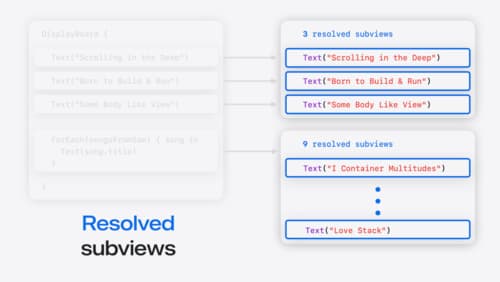swift ui list
Asked on 2024-08-01
1 search
SwiftUI provides a powerful and flexible way to create lists in your applications. Here are some key points about using lists in SwiftUI:
-
List Initialization:
- Lists can be initialized with a collection parameter, which is a convenience for creating a
ForEachview. This generates views for each element in a collection and provides those to its container. - You can also manually write out a set of views to create a list.
- Lists can be initialized with a collection parameter, which is a convenience for creating a
-
Customization:
- Lists can be customized through the use of view modifiers. For example, you can add swipe actions to each row.
- The
searchablemodifier can be applied to a list to make it searchable. This allows users to filter the content displayed in the list.
-
Composition:
- SwiftUI supports creating lists in various ways, including combining different kinds of content together using APIs for composition.
- You can incrementally build up an entire app by composing additional containers and modifiers.
-
State-Driven Views:
- SwiftUI views are state-driven. When your view state changes over time, SwiftUI automatically keeps your UI up to date.
-
Advanced Constructions:
- The view-based list initializer enables creating more advanced constructions, such as multiple collections of data organized into sections.
For more detailed information, you can refer to the following sessions from WWDC 2024:
- SwiftUI essentials (07:55)
- Demystify SwiftUI containers (03:07)
These sessions cover the fundamentals of using lists in SwiftUI, including initialization, customization, and composition.

Demystify SwiftUI containers
Learn about the capabilities of SwiftUI container views and build a mental model for how subviews are managed by their containers. Leverage new APIs to build your own custom containers, create modifiers to customize container content, and give your containers that extra polish that helps your apps stand out.

SwiftUI essentials
Join us on a tour of SwiftUI, Apple’s declarative user interface framework. Learn essential concepts for building apps in SwiftUI, like views, state variables, and layout. Discover the breadth of APIs for building fully featured experiences and crafting unique custom components. Whether you’re brand new to SwiftUI or an experienced developer, you’ll learn how to take advantage of what SwiftUI has to offer when building great apps.

Migrate your TVML app to SwiftUI
SwiftUI helps you build great apps on all Apple platforms and is the preferred toolkit for bringing your content into the living room with tvOS 18. Learn how to use SwiftUI to create familiar layouts and controls from TVMLKit, and get tips and best practices.
